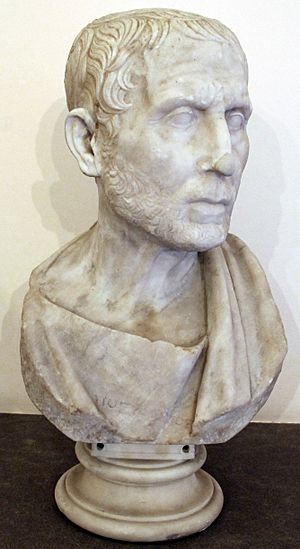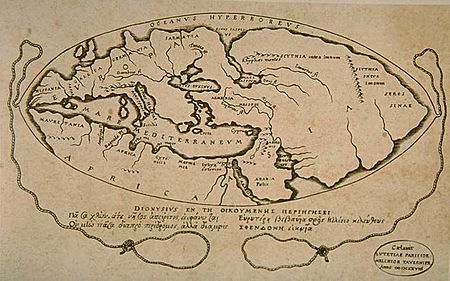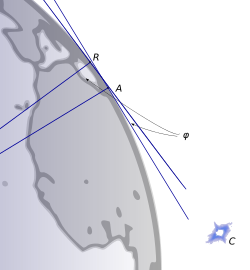Posidonius facts for kids
Quick facts for kids
Posidonius
|
|
|---|---|

Bust of Posidonius from the Naples National Archaeological Museum
|
|
| Born | c. 135 BC Apamea
|
| Died | c. 51 BC (aged 83–84) |
| Era | Hellenistic philosophy |
| Region | Western philosophy |
| School | Stoicism |
|
Main interests
|
Astronomy, geography, history, mathematics, meteorology, philosophy, physics |
Posidonius (born around 135 BC, died around 51 BC) was a very smart and famous Greek thinker. He was a politician, astronomer, geographer, historian, mathematician, and teacher. People thought he was the most knowledgeable person of his time. He was also a leading member of the Stoic school of philosophy.
Posidonius was born in Apamea, a city in Syria. He studied Stoic philosophy in Athens with Panaetius. After his studies, he traveled a lot to places like Spain, Africa, Italy, and Gaul. He gathered scientific information during these trips.
Later, he settled in Rhodes and became a teacher. Many students came to learn from him. Famous Romans like Pompey and Cicero knew him well. Posidonius helped spread Stoic ideas in the Roman world.
Most of his writings are now lost, but other writers used his ideas. He was interested in many subjects, from science to history. He tried to figure out the size of the Sun and Earth, and how the Moon affects tides.
Contents
Life and Education
Early Years and Learning
Posidonius was born around 135 BC in Apamea, a Greek city in Syria. He was sometimes called "the Athlete." Even though he was from Apamea, he didn't seem to like his hometown much.
When he was young, he moved to Athens. There, he studied with Panaetius, a very important Stoic philosopher. After Panaetius died in 110 BC, Posidonius moved to Rhodes. He became a citizen there and started his own school. His school became a leading place for learning at that time.
His Amazing Travels
Around 90 BC, Posidonius began many journeys around the Mediterranean Sea. He wanted to collect scientific information. He also wanted to learn about the customs and people of different places. He traveled to Greece, Spain, Italy, Sicily, Gaul, and North Africa.
In Spain, he saw how high the tides were on the Atlantic coast. He noticed that daily tides were linked to the Moon's movement. He also thought that tides changed with the Moon's cycles.
In Gaul, he studied the Celts. He wrote detailed descriptions of what he saw. He noted that the Celts respected their Druids, who he saw as philosophers. Posidonius wrote a book about the lands of the Celts, but it is now lost. However, other writers like Diodorus Siculus and Strabo used his information.
Political Role in Rhodes
Posidonius was active in the government of Rhodes. He became one of the Prytaneis, which was a very important political job. There were five or six men who held this position for six months.
He also went on a special trip to Rome in 87/86 BC. This was during a difficult time when Roman rule was being challenged.
The Stoic School in Rhodes
Under Posidonius, Rhodes became the main center for Stoic philosophy. Many Greek and Roman students came to his school. Famous Romans visited him.
Pompey, a powerful Roman general, attended Posidonius's lectures twice. Once, in 62 BC, Posidonius was lecturing about "moral good." He was suffering from gout at the time. He pointed to his painful leg and said, "It is no good, pain; bothersome you may be, but you will never persuade me that you are an evil." This showed his strong Stoic belief.
Cicero, a famous Roman speaker, also attended Posidonius's lectures. Cicero later called Posidonius "my teacher" and "my dear friend." Posidonius died around 51 BC. His grandson, Jason of Nysa, took over his school.
His Many Writings
Posidonius was known as a polymath, meaning he knew a lot about many different subjects. He tried to create a single system to understand the human mind and the universe. He wanted to explain how everything in the world worked together.
He wrote about many topics, including:
- Physics (like weather and geography)
- Astronomy and astrology
- Seismology (earthquakes)
- Geology and mineralogy
- Ethics (how to live a good life)
- Logic and mathematics
- History and natural history
- Anthropology (the study of human societies)
None of his original books have survived completely. We only have parts of them. Writers like Strabo and Seneca the Younger give us most of the information about his life and works.
His Philosophy
For Posidonius, philosophy was the most important subject. He believed all other sciences were part of philosophy. Philosophy helped explain the whole universe.
He followed the Stoic way of dividing philosophy into three parts:
- Physics: Understanding nature, the universe, and gods.
- Logic: How to think clearly and correctly.
- Ethics: How to live a good and moral life.
He saw these three parts as connected, like a living body. Physics was the body, logic was the bones, and ethics was the soul. Ethics was the most important part.
Posidonius was a strong Stoic, but he also used ideas from Plato and Aristotle. He even studied Plato's Timaeus, a book about the universe.
Ethics: Living a Good Life
Posidonius taught that ethics was not just about ideas, but about how you live your life. It meant understanding both humans and the universe. He believed human reason was connected to the universe's reason.
Some people thought Posidonius had different ideas about emotions than earlier Stoics. However, other writers like Cicero and Seneca saw his ideas as similar to other Stoics. He explored how our feelings connect with our thoughts.
Physics: How the Universe Works
Posidonius believed the universe was one big, connected system. He thought everything worked together, from the physical world to how living things behave. He believed the universe was organized and had a purpose.
He supported ideas like divination (predicting the future) and the Stoic idea of a future "cosmic fire" that would renew the universe. He believed that signs in nature, like those used in astrology or dreams, could predict things. This was because he saw everything in the universe as connected.
Mathematics: Solving Problems
Posidonius was one of the first people to try and prove Euclid's fifth postulate in geometry. This postulate is about parallel lines. He suggested a different way to define parallel lines to help prove it.
He also helped define mathematical terms like 'theorem' and 'problem'.
Astronomy and Weather
Some of his writings on astronomy survived through another book by Cleomedes. Posidonius believed the Sun gave off a powerful force that filled the world.
He tried to measure the distance and size of the Sun. Around 90 BC, he estimated the distance from Earth to the Sun. His estimate for the Sun's size was more accurate than other Greek astronomers.
Posidonius also calculated the size and distance of the Moon.
He built a model of the solar system called an orrery. This device showed how the Sun, Moon, and the five known planets moved each day. It might have been similar to the famous Antikythera mechanism.
In his writings about weather, he followed Aristotle's ideas. He wrote about how clouds, mist, wind, and rain form. He also discussed frost, hail, lightning, and rainbows. He estimated that clouds were about 40 stadia (a unit of length) above the Earth.
Geography and Earth's Size
Posidonius became famous for his book "About the ocean and the adjacent areas." This book explained geographical ideas and showed how everything in the world was connected. He believed this connection applied to human life and politics too.
He had a theory that climate affected people's character. He thought Italy's central location helped explain why Rome became so powerful. As a Stoic, he didn't see a huge difference between civilized Romans and other peoples.
Like Pytheas, Posidonius believed the tides were caused by the Moon. However, he was wrong about the exact reason. He thought the Moon's heat made the water swell.
He also wrote about earthquakes and volcanoes. He described eruptions in the Aeolian Islands near Sicily.
Measuring Earth's Circumference
Posidonius calculated the Earth's circumference using a star called Canopus. He observed that Canopus was just on the horizon in Rhodes. But in Alexandria, it was 7.5 degrees above the horizon.
He thought Rhodes was 5,000 stadia north of Alexandria. Since the star's height difference was 1/48 of a circle (360/7.5 = 48), he multiplied 5,000 by 48. This gave him 240,000 stadia for the Earth's circumference.
If we change his stadia to modern miles, 240,000 stadia is about 24,000 miles. The Earth's actual circumference is about 24,901 miles. So, his measurement was very close!
He was influenced by Eratosthenes, who had calculated the Earth's circumference earlier.
Some later writers, like Strabo, reported a smaller number for Posidonius's calculation (180,000 stadia). This smaller number was used by Ptolemy and later by Christopher Columbus. Columbus used this smaller number to wrongly estimate the distance to India.
History and Military Strategy
In his book Histories, Posidonius continued the work of Polybius. His history covered the period from 146 to 88 BC and was 52 volumes long. He seemed to support the rise of Roman power.
Posidonius believed that events were caused by human feelings and actions. He used his writing skills to show readers what was right or wrong.
He thought history was not just about people and politics. It also included how things like geography, resources, climate, and food affected humans. For example, he used climate to explain why different groups of people had certain characteristics.
He also wrote a book on military strategy called The Art of War. Another historian, Arrian, said it was written "for experts." This might mean Posidonius had some experience with military leadership, or learned from his friend Pompey.
His Influence and Fame
Posidonius was very famous in his time. His writings on philosophy made him well-known throughout the Greek and Roman world. Many writers quoted him, including Cicero, Livy, Plutarch, Strabo, and Seneca the Younger. Strabo called him "the most learned of all philosophers of my time."
Even though his writing style went out of fashion later, he was praised for his literary skills during his life.
Posidonius was a main source of information about the Celts of Gaul. Many important writers like Julius Caesar and Strabo used his descriptions.
He was friends with important Roman leaders. He met Pompey when he was an ambassador from Rhodes. Pompey visited him twice in Rhodes and even asked him to write his biography. As a sign of great respect, Pompey lowered his special rods (fasces) before Posidonius's door.
Ptolemy was impressed by Posidonius's careful methods. Ptolemy used Posidonius's calculation for the Earth's circumference. This made Posidonius's number the accepted value for the next 1,500 years, even though Eratosthenes's earlier number was more accurate.
Posidonius helped strengthen Stoic philosophy. He and his teacher Panaetius did the most to spread Stoicism in the Roman world. A century later, Seneca said Posidonius was one of the people who contributed the most to philosophy.
His ideas influenced Greek philosophy even into the Middle Ages. He is often mentioned in the Suda, a Byzantine encyclopedia from the 10th century.
Today, Posidonius is seen as a curious and broad-minded thinker. He connected all knowledge into one big, unified view of the world, based on his Stoic philosophy.
The crater Posidonius on the Moon is named after him.
Images for kids
See also
 In Spanish: Posidonio para niños
In Spanish: Posidonio para niños
- Eratosthenes (born around 276 BC, died around 194/195 BC), a Greek mathematician who calculated the circumference of the Earth and the distance from the Earth to the Sun.
- Twin study




